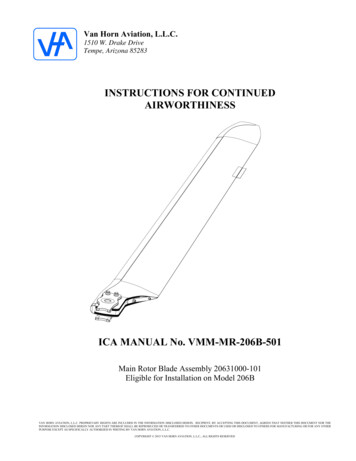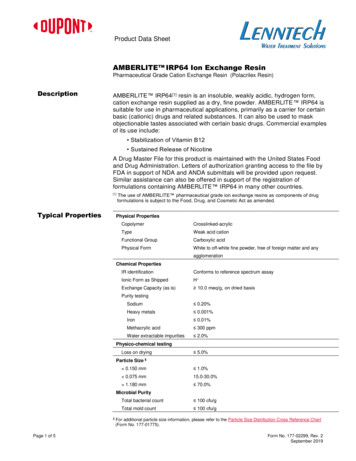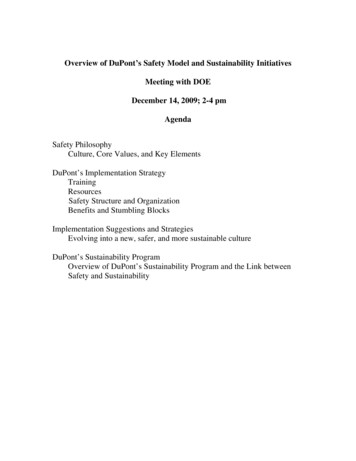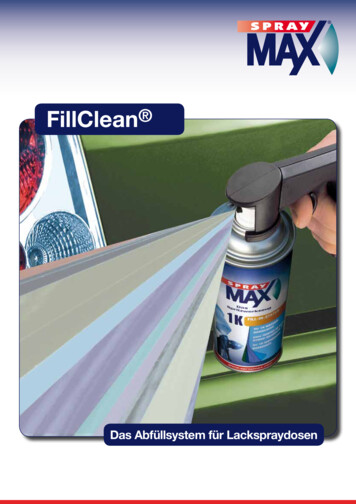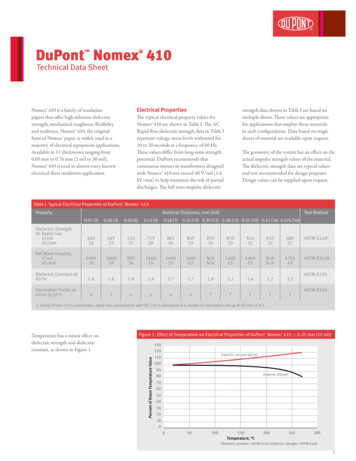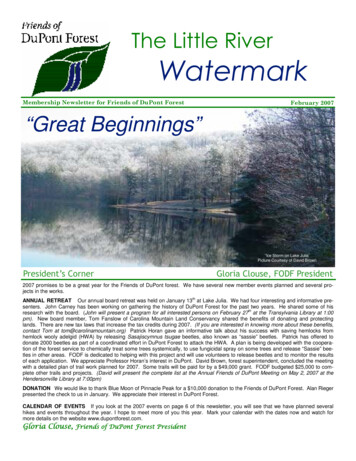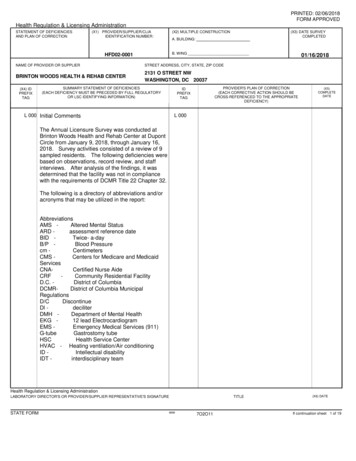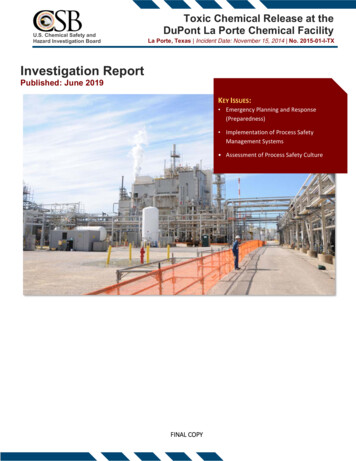
Transcription
U.S. Chemical Safety andHazard Investigation BoardToxic Chemical Release at theDuPont La Porte Chemical FacilityLa Porte, Texas Incident Date: November 15, 2014 No. 2015-01-I-TXInvestigation ReportPublished: June 2019Investigation ReportKEY ISSUES: Emergency Planning and Response(Preparedness) Implementation of Process SafetyManagement Systems Assessment of Process Safety CultureFINAL COPY
U.S. Chemical Safety andHazard Investigation BoardToxic Chemical Release at theDuPont La Porte Chemical FacilityLa Porte, Texas Incident Date: November 15, 2014 No. 2015-01-I-TXThe U.S. Chemical Safety and Hazard Investigation Board (CSB) is an independent federalagency whose mission is to drive chemical safety change through independent investigations toprotect people and the environment.The CSB is a scientific investigative organization, not an enforcement or regulatory body.Established by the Clean Air Act Amendments of 1990, the CSB is responsible for determiningaccident causes, issuing safety recommendations, studying chemical safety issues, and evaluating theeffectiveness of other government agencies involved in chemical safety. More information about theCSB is available at www.csb.gov.The CSB makes public its actions and decisions through investigative publications, all of which mayinclude safety recommendations when appropriate. Types of publications include:Investigation Reports: Formal, detailed reports on significant chemical incidents thatinclude key findings, root causes, and safety recommendationsInvestigation Digests: Plain-language summaries of Investigation ReportsCase Studies: Reports that examine fewer issues than Investigation ReportsSafety Bulletins: Short publications typically focused on a single safety topicHazard Investigations: Broader studies of significant chemical hazardsSafety Videos: Videos that animate aspects of an incident or amplify CSB safety messagesCSB products can be freely accessed at www.csb.gov or obtained by contacting:U.S. Chemical Safety and Hazard Investigation BoardOffice of Congressional, Public, and Board Affairs1750 Pennsylvania Ave NW, Suite 910Washington, DC 20006(202) 261-7600No part of the conclusions, findings, or recommendations of the Board relating to any accidentalrelease or the investigation thereof shall be admitted as evidence or used in any action or suit fordamages arising out of any matter mentioned in such report. See 42 U.S.C. § 7412(r)(6)(G).Page 2FINAL COPY
U.S. Chemical Safety andHazard Investigation BoardToxic Chemical Release at theDuPont La Porte Chemical FacilityLa Porte, Texas Incident Date: November 15, 2014 No. 2015-01-I-TXTABLE OF CONTENTS1EXECUTIVE SUMMARY . 72INCIDENT DESCRIPTION . 13METHYL MERCAPTAN RELEASE . 14EMERGENCY RESPONSE . 213DELAYED AWARENESS OF TOXIC CHEMICAL RELEASE BY OPERATIONS . 284EMERGENCY RESPONSE OPERATIONS . 31ERT BACKGROUND . 33PROCESS COORDINATOR WAS MISSING . 34DELAY IN ERT READINESS TO SEARCH FOR MISSING WORKERS . 384.3.1 Call for ERT Response . 384.3.2 ERT Mini‐Pumper Truck Not Operational . 39THE SEARCH FOR MISSING WORKERS WAS HIGH RISK . 404.4.1 Entry into Potentially Explosive Atmosphere . 414.4.2 No Technology to Locate Missing Workers . 434.4.3 Unrecognized Manufacturing Building Collapse Hazard . 43DIFFICULTIES NAVIGATING MANUFACTURING BUILDING . 44NO ANALYSIS OF PROCESS DATA TO IDENTIFY SOURCE OF LEAK . 47INADEQUATE CREATION AND CONTROL OF HOT ZONE . 50DEFICIENCIES IN EVALUATING RISK TO THE PUBLIC. 524.8.1 Release Modeling . 534.8.2 Physical Properties of Methyl Mercaptan. 564.8.3 Chemical Sensor Data . 584.8.4 Air Monitoring . 59EMERGENCY RESPONSE CONCLUSIONS . 605DUPONT’S PROCESS SAFETY MANAGEMENT SYSTEM . 61OSHA . 62The Process Safety Management Standard . 62DuPont La Porte’s Implementation of PSM . 63Recent Developments Affecting the PSM Standard . 65ENVIRONMENTAL PROTECTION AGENCY . 655.2.1 Risk Management Plan Rule . 655.2.2 DuPont La Porte’s Implementation of RMP . 675.2.3 Recent Developments Affecting the RMP Rule . 68AMERICAN CHEMISTRY COUNCIL. 695.3.1 History of Responsible Care . 705.3.2 Responsible Care Requirements . 715.3.3 Responsible Care Conformance Audits . 735.1.15.1.25.1.3Page 3FINAL COPY
U.S. Chemical Safety andHazard Investigation BoardToxic Chemical Release at theDuPont La Porte Chemical FacilityLa Porte, Texas Incident Date: November 15, 2014 No. 2015-01-I-TX5.3.45.3.5Recent Developments in Responsible Care . 76Responsible Care Improvement Opportunities . 77DUPONT’S DEVELOPMENT AND IMPLEMENTATION OF ITS PROCESS SAFETY MANAGEMENT SYSTEM . 805.4.1 Building a Safety Culture . 825.4.2 Using the Process Safety Management and Risk Model . 92DUPONT’S PROCESS SAFETY MANAGEMENT SYSTEM CONCLUSIONS . 946PROCESS SAFETY MANAGEMENT DEFICIENCIES . 94PROCESS HAZARD ANALYSIS EVALUATION . 95IMPLEMENTATION OF CORRECTIVE ACTIONS. 98PROCESS SAFETY PRACTICES DURING TROUBLESHOOTING OPERATIONS . 102MOC PRACTICES . 1036.4.1 No MOC for Heating Piping or for New Piping Alignment . 1046.4.2 No MOC for New Piping Alignment to Nitrogen Relief Valves . 1086.4.3 No MOC or Procedure for Vent Header Draining Operation . 109LINE‐BREAKING PRACTICES . 113SHIFT COMMUNICATION PRACTICES . 1177ADDITIONAL FACTS, CONDITIONS, AND CIRCUMSTANCES IDENTIFIED. 118EMPLOYEE INCENTIVE PROGRAM . 1198KEY FINDINGS . 1249SAFETY GUIDANCE . 12510RECOMMENDATIONS . 129DUPONT LA PORTE, TEXAS, CHEMICAL FACILITY . 129LOCAL 900C OF THE INTERNATIONAL CHEMICAL WORKERS UNION COUNCIL (ICWUC) OF THE UNITED FOOD AND COMMERCIALWORKERS (UFCW) . 131REFERENCES . 132APPENDIX A: CAUSAL ANALYSIS. 149APPENDIX B: INCIDENT TIMELINE . 150APPENDIX C: ODOR COMPLAINTS FROM NOVEMBER 15, 2014 . 155APPENDIX D: EMERGENCY RESPONSE TABLES . 156APPENDIX E: DUPONT SAFETY PERCEPTION SURVEYS . 161Page 4FINAL COPY
U.S. Chemical Safety andHazard Investigation BoardToxic Chemical Release at theDuPont La Porte Chemical FacilityLa Porte, Texas Incident Date: November 15, 2014 No. 2015-01-I-TXACRONYMS AND INITIALISMSAAOacetaldehyde oximeACCAmerican Chemistry CouncilAEGLacute exposure guideline levelAPIAmerican Petroleum InstituteCCPSCenter for Chemical Process SafetyCCTVclosed circuit televisionCSBU.S. Chemical Safety and Hazard Investigation BoardDCSdistributed control systemDOTU.S. Department of TransportationEMTemergency medical technicianEPAU.S. Environmental Protection AgencyEOCEmergency Operations CenterERPGsEmergency Response Planning GuidelinesERTemergency response teamFBUFluoroproducts Business UnitFEMAU.S. Federal Emergency Management AgencyHAZCOMHazard Communication StandardHAZWOPER Hazardous Waste Operations and Emergency Response StandardIBUInsecticide Business UnitICWUCInternational Chemical Workers Union CouncilIDLHImmediately Dangerous to Life or HealthLELlower explosive limitLFLlower flammability limitLPBCLocal Performance Based Compensation programMeSHmethyl mercaptanMICmethyl isocyanateMOCmanagement of changeMSDSmaterial safety data sheetPage 5FINAL COPY
U.S. Chemical Safety andHazard Investigation BoardToxic Chemical Release at theDuPont La Porte Chemical FacilityLa Porte, Texas Incident Date: November 15, 2014 No. 2015-01-I-TXNAICSNorth American Industrial Classification Systemmphmiles per hourNEPNational Emphasis ProgramNFPANational Fire Protection AssociationNIMSNational Incident Management SystemNIOSHNational Institute for Occupational Safety and HealthNRSNOx (nitrogen oxides) reduced scrubbedOSHAU.S. Occupational Safety and Health AdministrationOSH ActU.S. Occupational Safety and Health Act of 1970PELpermissible exposure limitPHAprocess hazard analysisppbparts per billionPPEpersonal protective equipmentppmparts per millionPSMProcess Safety ManagementRCMSResponsible Care Management System RCSRelative Culture StrengthRELrecommended exposure limitRMPRisk Management PlanSCBAself-contained breathing apparatusSDSsafety data sheetSHISubstance Hazards IndexTWATime-Weighted AverageUFCWUnited Food and Commercial WorkersPage 6FINAL COPY
U.S. Chemical Safety andHazard Investigation BoardToxic Chemical Release at theDuPont La Porte Chemical FacilityLa Porte, Texas Incident Date: November 15, 2014 No. 2015-01-I-TX1 EXECUTIVE SUMMARYOn November 15, 2014, approximately 24,000 poundsa of highly toxic methyl mercaptan was released from aninsecticide productionb unit (Lannate Unit) at the E. I. du Pont de Nemours and Company (DuPont) chemicalmanufacturing facility in La Porte, Texas.c The release killed three operators and a shift supervisor inside amanufacturing building.d They died from a combination of asphyxia and acute exposure (by inhalation) tomethyl mercaptan.The CSB determined that the cause of the highly toxic methyl mercaptan release was the flawed engineeringdesign and the lack of adequate safeguards.e Contributing to the severity of the incident were numerous safetymanagement system deficiencies, including deficiencies in formal process safety culture assessments, auditingand corrective actions, troubleshooting operations, management of change, safe work practices, shiftcommunications, building ventilation design, toxic gas detection, and emergency response. Weaknesses in theDuPont La Porte safety management systems resulted from a culture at the facility that did not effectivelysupport strong process safety performance.The highly toxic methyl mercaptan release resulted from a long chain of process safety management systemimplementation failures stemming from ineffective implementation of the process safety management system atthe DuPont La Porte facility.The CSB investigation viewed the chain of implementation failures as starting with the flawed engineeringdesign of the 20 million nitrogen oxides (NOx) reduced scrubbed (NRS) incinerator, a capital projectimplemented in 2011. DuPont La Porte had long-standing issues with vent piping to this incinerator because thedesign did not address liquid accumulation in waste gas vent header vapor piping to the NRS, and DuPont LaPorte did not fully resolve the liquid accumulation problem through hazard analyses or management of changereviews. Instead, to deal with these problems, daily instructions had been provided to operations personnel todrain liquid from these pipes to the atmosphere inside the Lannate manufacturing building without specificallyaddressing the potential safety hazards this action could pose to the workers. DuPont La Porte’s instructions didnot specify additional breathing protection for this task (Section 6.4.3 and Interim Recommendations) [1, p. 18].a29 C.F.R. § 1910.119 Appendix A (2013).The Insecticide Business Unit (IBU) was divided into two primary insecticide product lines: Lannate , which is DuPont’s trade namefor methomyl, and agricultural products intermediates, which were used to produce insecticides and nematicides known as Vydate , thetrade name for oxamyl [1, p. 11].cMultiple business units were located at the DuPont La Porte site. The Lannate Unit was part of the IBU. In addition to the IBU, thefacility had an Herbicides Business Unit and a Fluoroproducts Business Unit (FBU). The FBU included an anhydrous hydrogen fluoride(HF) manufacturing unit. FBU assets were sold to Chemours on July 1, 2015.dOne victim on the third floor was located near a methyl mercaptan leak source on the wet end (east) side. The other two victims on thethird floor were on the dry end (west) side. The IBU was further subdivided into four functional areas: the wet end, the MIC (methylisocyanate) area, the damp end, and the dry end. The wet end contained liquid reaction equipment. The MIC area contained equipmentto generate and consume the MIC intermediate. The damp end isolated and dried insecticide crystals. The dry end processed the crystalsand packaged them into various products [1, pp. 10-11].eIn September 2018, the CSB produced a Winterization Safety Digest that discussed DuPont La Porte’s lack of safeguards to preventmethyl mercaptan hydrate formation [173, p. 1].bPage 7FINAL COPY
U.S. Chemical Safety andHazard Investigation BoardToxic Chemical Release at theDuPont La Porte Chemical FacilityLa Porte, Texas Incident Date: November 15, 2014 No. 2015-01-I-TXOn the night of the incident, not realizing the hydrate blockage in the methyl mercaptan feed piping was cleared,workers went to drain liquid from the waste gas vent piping. They did not know that high pressure in the wastegas vent piping was related to the fact that liquid methyl mercaptan was flowing through the methyl mercaptanfeed piping and into the waste gas vent piping.The chain further developed when the ineffective building ventilation system failed to be addressed afterDuPont auditors identified it as a safety concern about five years before the incident. DuPont La Porte’smanagement system did not resolve the process safety management recommendation (i.e., did not takecorrective action) to address the building ventilation system (Section 6.1 and Interim Recommendations) [1, p.34]. The ventilation design for the manufacturing building was based on flammability characteristics and didnot take into consideration toxic chemical exposure hazards, even though the building contained two highlytoxic materials, chlorine and methyl mercaptan. DuPont La Porte records indicated that the manufacturingbuilding’s dilution air ventilation design was based on providing sufficient ventilation to ensure that theconcentration of flammable gases did not exceed 25 percent of the lower explosion limit (LEL).a At the time ofthe incident, neither of the manufacturing building’s two rooftop ventilation fans was working, despite an“urgent” work order written nearly a month earlier. Even had the fans worked, they probably would not haveprevented a lethal atmosphere inside the building due to the large amount of toxic gas released (Section 5.4.1.2and Interim Recommendations) [1, pp. 3, 33-34].DuPont La Porte’s installation of a methyl mercaptan detection system inside the manufacturing building addedanother link to the chain. Neither the workers nor the public was protected by DuPont’s toxic gas detectionsystem on the night of the incident. The building where the workers died was not equipped with an adequatetoxic gas detection system to alert personnel to the presence of dangerous chemicals. First, DuPont La Porte setthe detector alarms well above safe exposure limits for workers. Second, DuPont La Porte relied on verbalcommunication of alarms that automatically displayed on a continuously manned control board. Finally,DuPont La Porte did not provide visual lights or audible alarms for the manufacturing building to warn workersof highly toxic gas concentrations inside it. When a release caused a detector to register a concentration abovethe alarm limit, the toxic gas detection system did not warn workers in the field about the potential leak and theneed to evacuate. Among other factors, this detection system contributed to workers’ growing accustomed tosmelling the methyl mercaptan odor in the unit. Additionally, when the toxic gas detectors triggered alarms,DuPont La Porte personnel investigated potential methyl mercaptan leaks without using respiratory protection.Personnel normalized unsafe methyl mercaptan detection practices by using odor to detect the gas, furtheraDuPont records indicate that the manufacturing building ventilation system design code is NFPA 497, Recommended Practice for theClassification of Flammable Liquids, Gases, or Vapors and of Hazardous (Classified) Locations for Electrical Installations in ChemicalProcess Areas. NFPA 497 defines adequate ventilation as that sufficient to ensure that the concentration of flammable gases does notexceed 25 percent of the lower flammability limit (also referred to as lower explosion limit (LEL)) [136, p. 9]. However, there were noLEL detectors to monitor the atmospheric conditions inside the manufacturing building and alert workers of potential fire or explosionconditions. Furthermore, a methyl mercaptan concentration of 25 percent of the LEL is equivalent to 65 times greater than the 150 partsper million concentration that is considered immediately dangerous to life or health (IDLH).Page 8FINAL COPY
U.S. Chemical Safety andHazard Investigation BoardToxic Chemical Release at theDuPont La Porte Chemical FacilityLa Porte, Texas Incident Date: November 15, 2014 No. 2015-01-I-TXdeteriorating the importance or effectiveness of utilizing instrumentation in response to alarms signalingpotential toxic gas releases (Section 3 and Interim Recommendations) [1, pp. 38-39].In the spring of 2014, the chain propagated when DuPont La Porte’s interlock program did not requireverification that interlocks that had been bypassed for turnaround maintenance were returned to service beforethe plant resumed operating. Because of this ineffective program, a bypassed interlock caused acetaldehydeoxime (AAO), a critical raw material, to become diluted, leading to a shutdown of the Lannate Unit daysbefore the November 2014 incident.a During the shutdown, water entered the methyl mercaptan feed pipingand, due to the cold weather, formed a hydrate (an ice-like material) that plugged the piping and preventedworkers from restarting the unit. Furthermore, DuPont La Porte did not establish adequate safeguards after a2011 DuPont La Porte process hazard analysis identified hydrate formation in this piping, revealing yet anotherlink in the chain (Section 6.1 and Interim Recommendations) [1, p. 22].When the hydrate formed, lacking safeguards to control the potential safety hazards associated with dissociating(breaking up) the hydrate (such as using heat tracing to prevent the hydrate from forming a solid inside thepiping or developing a procedure to dissociate the hydrate safely), DuPont workers went into troubleshootingmode (Section 6.3). Ineffective hazard management while troubleshooting the plugged methyl mercaptan feedpiping formed yet another link in the chain and allowed liquid methyl mercaptan to flow into the waste gas ventheader piping toward the NRS incinerator—a location where it was never intended to go (Section 6.4.1 andInterim Recommendations) [1, pp. 25-26]. As discussed earlier, DuPont La Porte did not fully resolve liquidaccumulation in the waste gas vent header by the NRS incinerator. Consequently, DuPont La Porte workersdealt with the common problem of liquid accumulation in the waste gas vent header on a routine basis bydraining the liquid (line breaking) without an engineered solution or without ensuring the use of safetyprocedures or personal protective equipment (Section 6.4.3 and Interim Recommendations) [1, pp. 18, 28].However, when the liquid drain valves were opened on November 15, 2014, flammable and highly toxic methylmercaptan flowed onto the floor and filled the manufacturing building with toxic vapor.Once the methyl mercaptan release began, an ineffective emergency response program at La Porte contributed tothe extent and duration of the chemical release, placed other workers in harm’s way, and did not effectivelyevaluate whether the chemical release posed a safety threat to the public (Section 3 and Section 4).aDuring the AAO truck unloading, a block valve downstream of what should have been an out-of-service water dilution control valvewas inadvertently opened, allowing water to flow into the tank. The water dilution system had been installed in 2006 when containershipments of 100 percent AAO were judged to be more economical than diluted AAO. AAO is now typically purchased and stored as a50 percent solution with water. A logistical problem resulted in an unusual delivery of 50 percent AAO by tank truck instead of byrailcar. Two factors contributed to the tank overflow incident. First, DuPont did not have a procedure for unloading a 50 percent tanktruck of AAO. Second, the AAO water dilution control valve was supposed to interlock closed when (1) the truck-unloading pump wasoff or (2) the AAO tank had a high liquid level. However, the interlock function had been bypassed in the field so that water could beused to decontaminate the tank during the turnaround in spring 2014. Instrument air supply tubing was connected directly to theinterlock valve actuator, bypassing the interlock activation solenoid, and forcing the valve to remain fully open. The interlock could notfunction because the bypass was not removed at the completion of the turnaround [1, p. 33]. DuPont defines a safety interlock as asystem or function that detects an out-of-limits (abnormal) condition or improper sequence and brings it to a safe condition [1, p. 38].Page 9FINAL COPY
U.S. Chemical Safety andHazard Investigation BoardToxic Chemical Release at theDuPont La Porte Chemical FacilityLa Porte, Texas Incident Date: November 15, 2014 No. 2015-01-I-TXThis chain of events illustrates DuPont La Porte’s ineffective implementation of its process safety managementsystem. The individual components of this process safety management system exhibited cross-cuttingweaknesses, resulting in the deaths of four workers and leading to the ultimate decision to close the DuPont LaPorte facility.The DuPont La Porte incident is the CSB’s third investigation of a fatal DuPont incident in five years.a OnSeptember 30, 2015, the CSB issued a presentation, a safety video, and an Interim Recommendations report [1],which detailed needed safety improvements at the DuPont La Porte facility and issued recommendations forimplementation before resuming operations of the Lannate Unit [2].b Due to the amount of methyl mercaptanstored at the DuPont La Porte site, the Lannate process was covered by the Process Safety Management (PSM)standard of the U.S. Occupational Safety and Health Administration (OSHA) and the Risk Management Plan(RMP) rule of the U.S. Environmental Protection Agency (EPA) [3]. In the Interim Recommendations, the CSBidentified significant process safety management deficiencies at the La Porte facility, including delayedmaintenance of safety-critical equipment, lack of written procedures, poor hazard analysis practices, lack ofimplementation of important inherently safer design concepts, and a lack of hazard recognition [1].In response to the CSB findings and recommendations, DuPont committed to making changes at the La Portefacility. DuPont La Porte, however, was not able to address all of these findings and recommendations, becausein the spring of 2016 DuPont announced that it would not reopen the Lannate Unit. The company haddetermined that “significant changes in market conditions during the period of the shutdown [would] persistover the long term” [4] and that the cost required for the resta
DuPont La Porte Chemical Facility La Porte, Texas Incident Date: November 15, 2014 No. 2015-01-I-TX U.S. Chemical Safety and Hazard Investigation Board Investigation Report Published: June 2019 KEY ISSUES: Emergency Planning and Response (Preparedness) Implementation of Process Safety Management Systems
